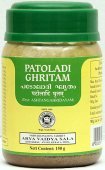Patoladi, Patola-adi, Paṭolādi: 2 definitions
Introduction:
Patoladi means something in Hinduism, Sanskrit. If you want to know the exact meaning, history, etymology or English translation of this term then check out the descriptions on this page. Add your comment or reference to a book if you want to contribute to this summary article.
In Hinduism
Ayurveda (science of life)
Kalpa (Formulas, Drug prescriptions and other Medicinal preparations)
Source: Shodhganga: Edition translation and critical study of yogasarasamgraha1) Paṭolādi refers to a medicinal recipe mentioned in the Kaṣāyakhaṇḍa (verse 1.88) of the 15th-century Yogasārasaṅgraha (Yogasara-saṅgraha) by Vāsudeva: an unpublished Keralite work representing an Ayurvedic compendium of medicinal recipes. The Kaṣāyakhaṇḍa [mentioning paṭolādi] deals with decoctions (kaṣāya) and gruels (peyas) administered to patients suffering from a variety of conditions (viz., alcoholism, vomiting, syncope, burning sensations, etc.).
2) Paṭolādi refers to a medicinal recipe mentioned in the Khalakhaṇḍa (verse 2.7) of the 15th-century Yogasārasaṅgraha (Yogasara-saṅgraha) by Vāsudeva: an unpublished Keralite work representing an Ayurvedic compendium of medicinal recipes. The Khalakhaṇḍa [mentioning paṭolādi] is named after Khala, in which the medium (of recipes) is buttermilk, and has been given such importance that a whole chapter is being left for it. Recipes treat patients suffering from a variety of conditions (viz., fever, haemorrhagic diseases, piles, etc.)
3) Paṭolādi refers to a medicinal recipe mentioned in the Lepakhaṇḍa (verse 4.140) of the 15th-century Yogasārasaṅgraha (Yogasara-saṅgraha) by Vāsudeva: an unpublished Keralite work representing an Ayurvedic compendium of medicinal recipes. The Lepakhaṇḍa [mentioning paṭolādi] contains recipes according to circumstances as advised by tradition. They treat the patient suffering from conditions such as fever, piles, emaciation, anorexia, tuberculosis, diarrhea, etc.
4) Paṭolādi refers to a medicinal recipe mentioned in the Ghṛtakhaṇḍa (verse 5.76) of the 15th-century Yogasārasaṅgraha (Yogasara-saṅgraha) by Vāsudeva: an unpublished Keralite work representing an Ayurvedic compendium of medicinal recipes. The Ghṛtakhaṇḍa [mentioning paṭolādi] refers to recipes based on medicated ghees (ghṛta), which are also administered as rejuvenators besides as curative medicine. They treat patients suffering from conditions such as seizure, fever, different skin diseases, lack of semen, lack of remembrance, etc.
Unclassified Ayurveda definitions
Source: archive.org: Sushruta samhita, Volume IThe drugs known as
- Patola,
- Chandana,
- Kuchandana,
- Murvā,
- Guduchi,
- Pāthā,
- and Katurohini
form the group known as the Patolādi Gana.
The group is a febrifuge and anti-toxic, and its therapeutic action consists in destroying the action of the deranged Pittam and Kapham. It restores the natural relish of the patient for food, removes vomiting, and proves beneficial in ulcers, and itching erythematous eruptions.

Āyurveda (आयुर्वेद, ayurveda) is a branch of Indian science dealing with medicine, herbalism, taxology, anatomy, surgery, alchemy and related topics. Traditional practice of Āyurveda in ancient India dates back to at least the first millenium BC. Literature is commonly written in Sanskrit using various poetic metres.
See also (Relevant definitions)
Starts with: Patoladikvatha.
Full-text: Patoladikvatha.
Relevant text
Search found 3 books and stories containing Patoladi, Patola-adi, Paṭola-ādi, Paṭolādi; (plurals include: Patoladis, adis, ādis, Paṭolādis). You can also click to the full overview containing English textual excerpts. Below are direct links for the most relevant articles:
Sushruta Samhita, volume 1: Sutrasthana (by Kaviraj Kunja Lal Bhishagratna)
Sushruta Samhita, volume 4: Cikitsasthana (by Kaviraj Kunja Lal Bhishagratna)
Sushruta Samhita, Volume 6: Uttara-tantra (by Kaviraj Kunja Lal Bhishagratna)
Chapter XXXIX - Symptoms and Treatment of Fever (Jvara) < [Canto III - Kaya-chikitsa-tantra (internal medicine)]
Related products

